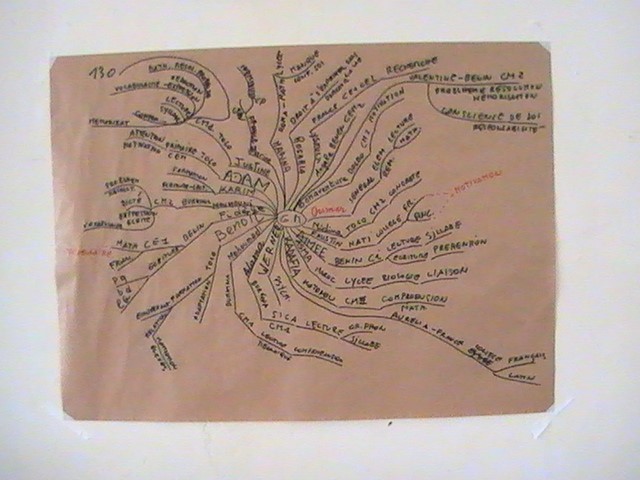The 31st RIDEF in Benin continues its course.
The principle events of yesterday, July 20 2016, were the workshops, informal meetings and the first part of the general assembly of the International Federation of Freinet Movements (FIMEM). The day was closed with an intercultural evening consisting of an eclectic mix of modern and traditional music and dance.
All these moments were an opportunity to share and refresh friendships and particularly exchange of the rich experiences between the participants.
WORKSHOP "RECOGNIZE AND RESPECT THE MENTAL AND PEDAGOGICAL IDENTITY OF STUDENTS FOR THE RIGHT TO EDUCATION FOR ALL.”
(Ermanno Tarrachini) Wednesday, 20/07/2016
(Ermanno Tarrachini) Wednesday, 20/07/2016
MENTAL GESTURES
Mind maps
Ermanno asks us to share different pieces of information that he puts on a mind map on the blackboard (see photo). On each branch he puts the name of the participant, their work place, at which age they teach, a keyword to characterise their personal practice, and the main problems encountered in their class (e.g., motivation, understanding, vocabulary, number of pupils).
 |
The mind map structures the information in a logical way, which leads to better memory and understanding, through various channels or modalities: the eyes (visual-spatial), oral and linear editing (text) by the student from his mental map.
Students must build it themselves, individually, but it is the teacher who initiates the practice, with examples (intervention by Angela).
Ermanno talks about a student who says "I AM", but who is not There (space) or now (Time). Aurelia speaks about a student who stays within himself.
Introduction of the participants
Secondly, Ermanno invites each participant to draw a mind map for a problem he freely chooses, but related to their classroom practice.
Then some participants come to present their mind map to the whole group, who react, ask for clarification, and Ermanno comments in the context of the theme of the workshop.
Secondly, Ermanno invites each participant to draw a mind map for a problem he freely chooses, but related to their classroom practice.
Then some participants come to present their mind map to the whole group, who react, ask for clarification, and Ermanno comments in the context of the theme of the workshop.
Regarding the possibility raised by one of the participants to use this individual mind map as a transmission tool for teachers during the transition to the upper class, Valentine points out that this may reduce learning because the learner is not "frozen".
Ader underlines the difficulty of using this tool individually given the often overfull classrooms in Africa (up to 192 for one participant!). Ermanno proposes a possible solution: make groups according representation modalities (visual, auditory, kinesthetic, etc.).